

Compact Muon Solenoid
LHC, CERN
| CMS-HIG-18-023 ; CERN-EP-2019-231 | ||
| Search for a heavy pseudoscalar Higgs boson decaying into a 125 GeV Higgs boson and a Z boson in final states with two tau and two light leptons at $\sqrt{s} = $ 13 TeV | ||
| CMS Collaboration | ||
| 25 October 2019 | ||
| JHEP 03 (2020) 065 | ||
| Abstract: A search is performed for a pseudoscalar Higgs boson, A, decaying into a 125 GeV Higgs boson h and a Z boson. The h boson is specifically targeted in its decay into a pair of tau leptons, while the Z boson decays into a pair of electrons or muons. A data sample of proton-proton collisions collected by the CMS experiment at the LHC at $\sqrt{s} = $ 13 TeV is used, corresponding to an integrated luminosity of 35.9 fb$^{-1}$. No excess above the standard model background expectations is observed in data. A model-independent upper limit is set on the product of the gluon fusion production cross section for the A boson and the branching fraction to $\mathrm{Z}\mathrm{h}\to\ell\ell\tau\tau$. The observed upper limit at 95% confidence level ranges from 27 to 5 fb for A boson masses from 220 to 400 GeV, respectively. The results are used to constrain the extended Higgs sector parameters for two benchmark scenarios of the minimal supersymmetric standard model. | ||
| Links: e-print arXiv:1910.11634 [hep-ex] (PDF) ; CDS record ; inSPIRE record ; HepData record ; CADI line (restricted) ; | ||
| Figures & Tables | Summary | Additional Figures | References | CMS Publications |
|---|
| Figures | |

png pdf |
Figure 1:
Feynman diagrams for two dominant production processes for the pseudoscalar A boson: gluon fusion (left) and associated production with b quarks (right). In both cases the A boson decays into a 125 GeV Higgs boson and a Z boson. |
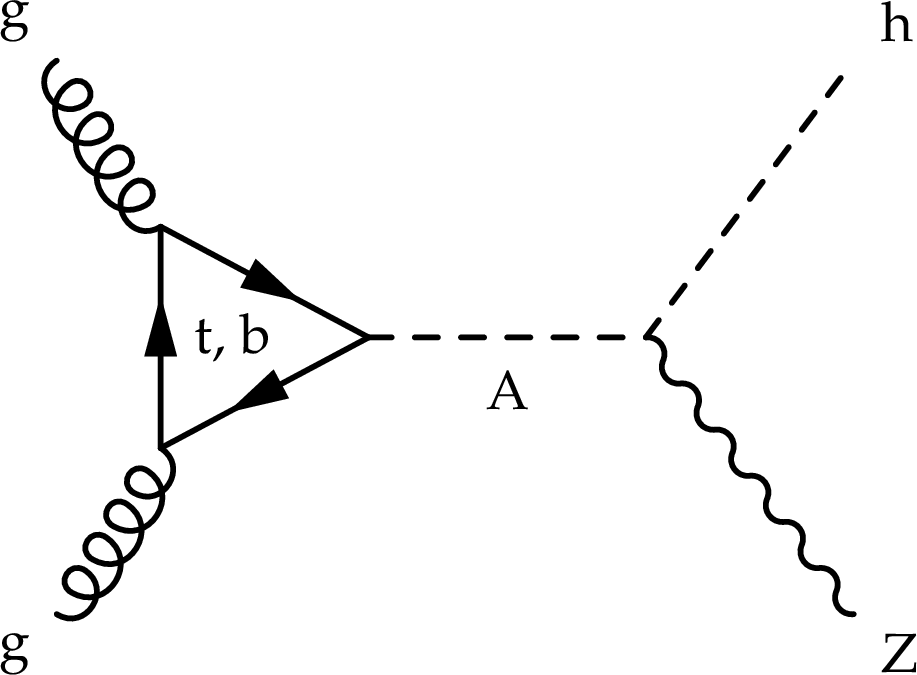
png pdf |
Figure 1-a:
Feynman diagram for the gluon fusion production of the pseudoscalar A boson. The A boson decays into a 125 GeV Higgs boson and a Z boson. |
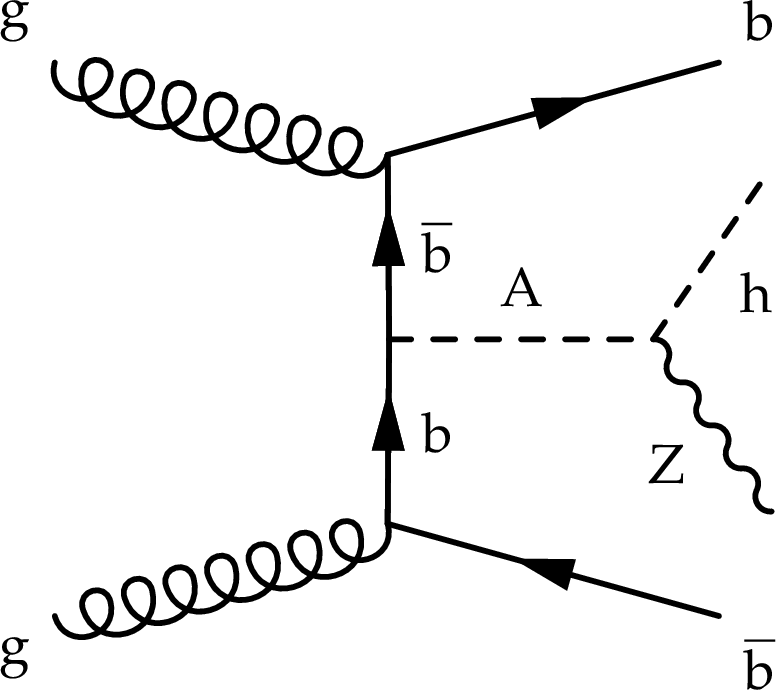
png pdf |
Figure 1-b:
Feynman diagram for the associated production with b quarks of the pseudoscalar A boson: gluon fusion (left) and associated production with b quarks (right). In both cases the A boson decays into a 125 GeV Higgs boson and a Z boson. |
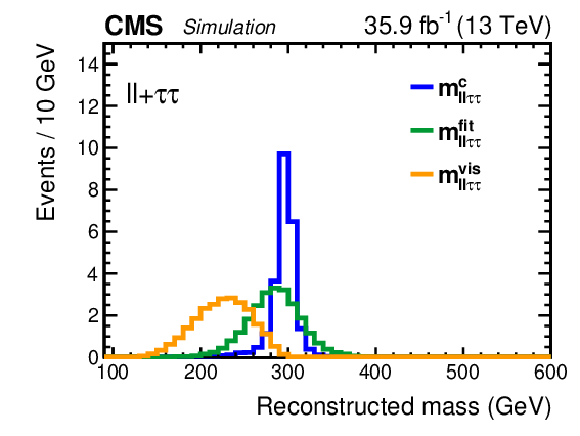
png pdf |
Figure 2:
The distribution of the A boson mass for the three studied mass reconstruction methods at 300 GeV : using only the visible decay products ($ {m^\text {vis}_{\ell \ell \tau \tau}} $, orange), using the SVFIT algorithm ($ {m_{\ell \ell \tau \tau}} ^{\mathrm {fit}}$, green), and using the SVFIT algorithm with a mass constraint of 125 GeV for the Higgs boson ($ {m_{\ell \ell \tau \tau}} ^{\mathrm {c}}$, blue). The eight final states of the A boson decay are combined for visualization purposes. |

png pdf |
Figure 3:
The reconstructed mass $ {m_{\ell \ell \tau \tau}} ^{\mathrm {c}}$ distributions and uncertainties after a background-only fit for the $\ell \ell +\mathrm{e} {\tau _\mathrm {h}} $ (upper left), $\ell \ell +\mu {\tau _\mathrm {h}} $ (upper right), $\ell \ell + {\tau _\mathrm {h}} {\tau _\mathrm {h}} $ (lower left), and $\ell \ell +\mathrm{e} \mu $ (lower right) channels. In all cases the two decay channels of the Z boson are included as separate distributions in the simultaneous fit; combining them together is for visualization purposes only. The uncertainties include both statistical and systematic components. The expected contribution from the $ \text {A} \to \mathrm{Z} \mathrm{h} $ signal process is shown for a pseudoscalar Higgs boson with $ {m_\text {A}} = $ 300 GeV with the product of the cross section and branching fraction of 20 fb and is for illustration only. |
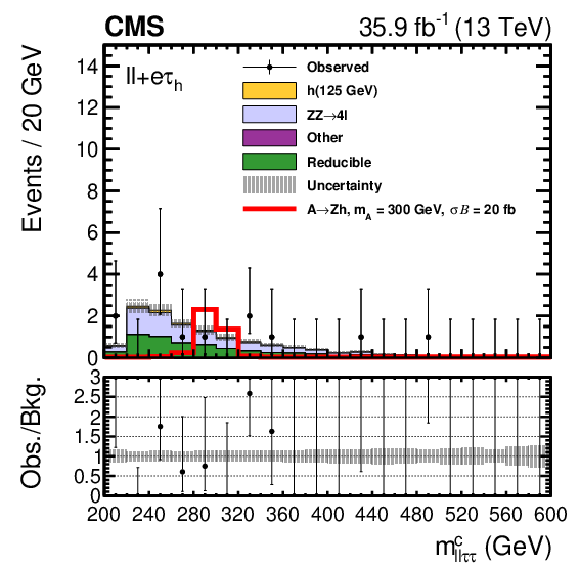
png pdf |
Figure 3-a:
The reconstructed mass $ {m_{\ell \ell \tau \tau}} ^{\mathrm {c}}$ distributions and uncertainties after a background-only fit for the $\ell \ell +\mathrm{e} {\tau _\mathrm {h}} $ channel. The two decay channels of the Z boson are included as separate distributions in the simultaneous fit; combining them together is for visualization purposes only. The uncertainties include both statistical and systematic components. The expected contribution from the $ \text {A} \to \mathrm{Z} \mathrm{h} $ signal process is shown for a pseudoscalar Higgs boson with $ {m_\text {A}} = $ 300 GeV with the product of the cross section and branching fraction of 20 fb and is for illustration only. |

png pdf |
Figure 3-b:
The reconstructed mass $ {m_{\ell \ell \tau \tau}} ^{\mathrm {c}}$ distributions and uncertainties after a background-only fit for the $\ell \ell +\mu {\tau _\mathrm {h}} $ channel. The two decay channels of the Z boson are included as separate distributions in the simultaneous fit; combining them together is for visualization purposes only. The uncertainties include both statistical and systematic components. The expected contribution from the $ \text {A} \to \mathrm{Z} \mathrm{h} $ signal process is shown for a pseudoscalar Higgs boson with $ {m_\text {A}} = $ 300 GeV with the product of the cross section and branching fraction of 20 fb and is for illustration only. |

png pdf |
Figure 3-c:
The reconstructed mass $ {m_{\ell \ell \tau \tau}} ^{\mathrm {c}}$ distributions and uncertainties after a background-only fit for the $\ell \ell + {\tau _\mathrm {h}} {\tau _\mathrm {h}} $ channel. The two decay channels of the Z boson are included as separate distributions in the simultaneous fit; combining them together is for visualization purposes only. The uncertainties include both statistical and systematic components. The expected contribution from the $ \text {A} \to \mathrm{Z} \mathrm{h} $ signal process is shown for a pseudoscalar Higgs boson with $ {m_\text {A}} = $ 300 GeV with the product of the cross section and branching fraction of 20 fb and is for illustration only. |

png pdf |
Figure 3-d:
The reconstructed mass $ {m_{\ell \ell \tau \tau}} ^{\mathrm {c}}$ distributions and uncertainties after a background-only fit for the $\ell \ell +\mathrm{e} \mu $ channel. The two decay channels of the Z boson are included as separate distributions in the simultaneous fit; combining them together is for visualization purposes only. The uncertainties include both statistical and systematic components. The expected contribution from the $ \text {A} \to \mathrm{Z} \mathrm{h} $ signal process is shown for a pseudoscalar Higgs boson with $ {m_\text {A}} = $ 300 GeV with the product of the cross section and branching fraction of 20 fb and is for illustration only. |
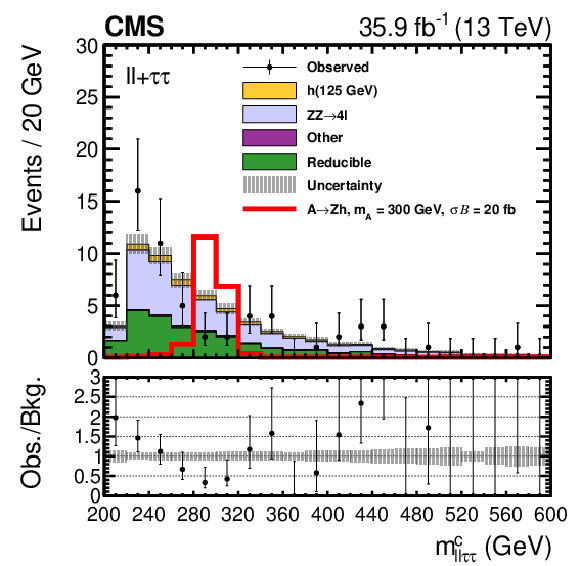
png pdf |
Figure 4:
The reconstructed mass $ {m_{\ell \ell \tau \tau}} ^{\mathrm {c}}$ distribution and uncertainties after a background-only fit in all eight final states. The final states are included as separate distributions in the simultaneous fit; combining them together is for visualization purposes only. The uncertainties include both statistical and systematic components. The expected contribution from the $ \text {A} \to \mathrm{Z} \mathrm{h} $ signal process is shown for a pseudoscalar Higgs boson with $ {m_\text {A}} = $ 300 GeV with the product of the cross section and branching fraction of 20 fb and is for illustration only. |
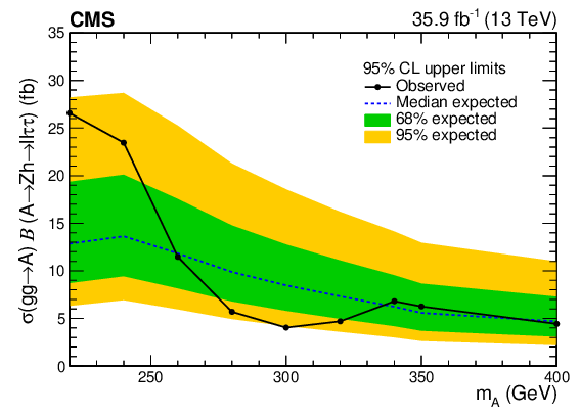
png pdf |
Figure 5:
The expected and observed 95% CL model-independent upper limits on the product of the cross section and branching fraction $\sigma (\mathrm{g} \mathrm{g} \to \text {A})\mathcal {B}(\text {A} \to \mathrm{Z} \mathrm{h} \to \ell \ell \tau \tau)$ are shown. The green (yellow) band corresponds to the 68 (95)% confidence intervals for the expected limit. |

png pdf |
Figure 6:
The expected and observed 95% CL exclusion limits in the $ {m_\text {A}} $-$ {\tan\beta} $ plane are shown for two MSSM scenarios: $\mathrm {M^{125}_{\mathrm{h},EFT}}$ (left) and hMSSM (right). The area under the solid black curve is excluded. The dashed black curve corresponds to the median expected limit, surrounded by the 68 (95)% confidence intervals in blue (red). The limits are overlaid on a background showing the $\sigma (\mathrm{g} \mathrm{g} \to \text {A} +\mathrm{b} {}\mathrm{\bar{b}} \text {A})\mathcal {B}(\text {A} \to \mathrm{Z} \mathrm{h} \to \ell \ell \tau \tau)$ as predicted by each model at each grid point. |
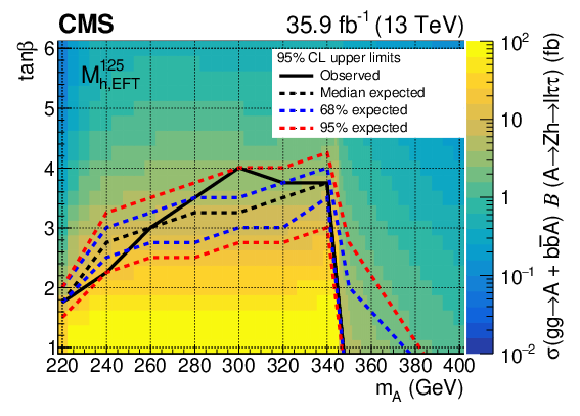
png pdf |
Figure 6-a:
The expected and observed 95% CL exclusion limits in the $ {m_\text {A}} $-$ {\tan\beta} $ plane are shown for the $\mathrm {M^{125}_{\mathrm{h},EFT}}$ scenario. The area under the solid black curve is excluded. The dashed black curve corresponds to the median expected limit, surrounded by the 68 (95)% confidence intervals in blue (red). The limits are overlaid on a background showing the $\sigma (\mathrm{g} \mathrm{g} \to \text {A} +\mathrm{b} {}\mathrm{\bar{b}} \text {A})\mathcal {B}(\text {A} \to \mathrm{Z} \mathrm{h} \to \ell \ell \tau \tau)$ as predicted by each model at each grid point. |

png pdf |
Figure 6-b:
The expected and observed 95% CL exclusion limits in the $ {m_\text {A}} $-$ {\tan\beta} $ plane are shown for the hMSSM scenario. The area under the solid black curve is excluded. The dashed black curve corresponds to the median expected limit, surrounded by the 68 (95)% confidence intervals in blue (red). The limits are overlaid on a background showing the $\sigma (\mathrm{g} \mathrm{g} \to \text {A} +\mathrm{b} {}\mathrm{\bar{b}} \text {A})\mathcal {B}(\text {A} \to \mathrm{Z} \mathrm{h} \to \ell \ell \tau \tau)$ as predicted by each model at each grid point. |
| Tables | |

png pdf |
Table 1:
Trigger and offline selection requirements for the different Z boson decay modes. The events are selected using either dilepton triggers with lower-$ {p_{\mathrm {T}}} $ thresholds or single-lepton triggers with higher-$ {p_{\mathrm {T}}} $ thresholds. The subscripts 1 and 2 indicate the higher- and lower-$ {p_{\mathrm {T}}} $ leptons associated with the Z boson, respectively. |

png pdf |
Table 2:
Kinematic selection requirements for each A boson decay channel, applied on top of the looser selections and b jet veto described in the text. The efficiency of the identification (and isolation) requirement for a given lepton type is labeled $\epsilon _{\mathrm {id.}}^{\ell}$. The leptons assigned to the Higgs boson are required to have opposite charge. To increase the sensitivity, we require $ {m_{\tau \tau}} ^{\mathrm {fit}}$ to be within 90-180 GeV. In the $\ell \ell + {\tau _\mathrm {h}} {\tau _\mathrm {h}} $ channel, we additionally require $ {L_\text {{T}}^\text {{h}}} > $ 60 GeV, where $ {L_\text {{T}}^\text {{h}}} $ is the scalar ${p_{\mathrm {T}}}$ sum of the visible decay products of the Higgs boson. |
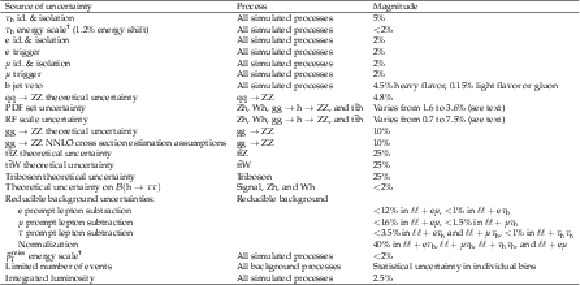
png pdf |
Table 3:
Sources of systematic uncertainty. The sign $\dagger $ marks the uncertainties that affect both the shape and normalization of the final $ {m_{\ell \ell \tau \tau}} ^{\mathrm {c}}$ distributions. Uncertainties that only affect the normalizations have no marker. For the shape and normalization uncertainties, the magnitude column lists an approximation of the associated change in the normalization of the affected processes. |

png pdf |
Table 4:
Background and signal expectations together with the numbers of observed events, for the signal region distributions after a background-only fit. The expected contribution from the $ \text {A} \to \mathrm{Z} \mathrm{h} $ signal process is given for a pseudoscalar Higgs boson with $ {m_\text {A}} = $ 300 GeV with the product of the cross section and branching fraction of 20 fb. The background uncertainty accounts for all sources of background uncertainty, systematic as well as statistical, after the simultaneous fit. |
| Summary |
| A search is presented for a pseudoscalar Higgs boson decaying into a 125 GeV Higgs boson, which further decays into tau leptons, and a Z boson that decays into a pair of electrons or muons. A data sample of proton-proton collisions collected at $\sqrt{s} = $ 13 TeV by the CMS experiment at the LHC is used, corresponding to an integrated luminosity of 35.9 fb$^{-1}$. The sensitivity of the study is increased by using the information on the Higgs boson mass [13] when reconstructing the mass of the pseudoscalar Higgs boson. The signal extraction is further optimized with kinematic selections based on the mass of the Higgs boson. The data agree with the background predictions from the standard model. The observed model-independent limits at 95% confidence level on the product $\sigma(\mathrm{g}\mathrm{g}\to\text{A} )\mathcal{B}(\text{A} \to\mathrm{Z}\mathrm{h}\to\ell\ell\tau\tau)$ range from 27 to 5 fb for A boson mass 220 to 400 GeV, respectively. The model-independent limits are interpreted in terms of $\sigma(\mathrm{g}\mathrm{g}\to\text{A} +\mathrm{b\bar{b}}\text{A} )\mathcal{B}(\text{A} \to\mathrm{Z}\mathrm{h}\to\ell\ell\tau\tau)$ for calculation of the model-dependent limits in two minimal supersymmetric standard model scenarios, $\mathrm{M^{125}_{\mathrm{h},EFT}}$ and hMSSM. In the $\mathrm{M^{125}_{\mathrm{h},EFT}}$ (hMSSM) scenario, the observed limits exclude $\tan\beta$ values below 1.8 (1.6) at ${m_\text{A}} = $ 220 GeV and 4.0 (3.7) at ${m_\text{A}} = $ 300 GeV at 95% confidence level. |
| Additional Figures | |

png pdf |
Additional Figure 1:
The reconstructed mass $m_{\ell \ell {\tau} {\tau}}^{\mathrm {fit}}$ distribution and uncertainties before a background-only fit is performed simultaneously in all eight final states. All signal region selections except the requirement for the SM-like Higgs boson mass $m_{{\tau} {\tau}}^{\mathrm {fit}}$ to be within 90-180 GeV were applied. The eight final states are combined together only for visualization purposes. The uncertainties include both statistical and systematic components. The expected contribution from the $\mathrm {A}\to {\mathrm {Z}} {\mathrm {h}} $ signal process is shown for a pseudoscalar Higgs boson with $m_{\text {A}} = $ 300 GeV with the product of the cross section and branching fraction of 20 fb and is for illustration only. |

png pdf |
Additional Figure 2:
The reconstructed mass $m_{\ell \ell {\tau} {\tau}}^{\mathrm {c}}$ distribution and uncertainties before a background-only fit is performed simultaneously in all eight final states. All signal region selections except the requirement for the SM-like Higgs boson mass $m_{{\tau} {\tau}}^{\mathrm {fit}}$ to be within 90-180 GeV were applied. The eight final states are combined together only for visualization purposes. The uncertainties include both statistical and systematic components. The expected contribution from the $\mathrm {A}\to {\mathrm {Z}} {\mathrm {h}} $ signal process is shown for a pseudoscalar Higgs boson with $m_{\text {A}} = $ 300 GeV with the product of the cross section and branching fraction of 20 fb and is for illustration only. |

png pdf |
Additional Figure 3:
The expected and observed 95% CL exclusion limits in the $m_{\text {A}}$-$\tan\beta $ plane are shown for the low-tb-high scenario when only the gluon fusion production process is included. The area under the solid black curve is excluded. The dashed black curve corresponds to the median expected limit, surrounded by the 68 (95)% confidence intervals in blue (red). The limits are overlaid on a background showing the $\sigma ({\mathrm {g}} {\mathrm {g}} \to \text {A})\mathcal {B}(\text {A}\to {\mathrm {Z}} {\mathrm {h}} \to \ell \ell \tau \tau)$ as predicted by the model at each grid point. |
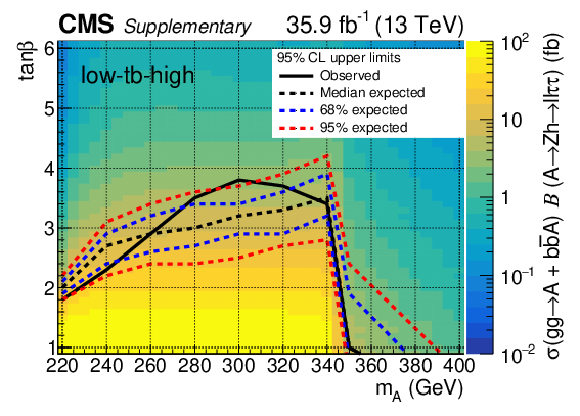
png pdf |
Additional Figure 4:
The expected and observed 95% CL exclusion limits in the $m_{\text {A}}$-$\tan\beta $ plane are shown for the low-tb-high scenario when both the gluon fusion and the $ {\mathrm {b}}$ quark associated production processes are included. The area under the solid black curve is excluded. The dashed black curve corresponds to the median expected limit, surrounded by the 68 (95)% confidence intervals in blue (red). The limits are overlaid on a background showing the $\sigma ({\mathrm {g}} {\mathrm {g}} \to \text {A}+ {{\mathrm {b}} {\overline {\mathrm {b}}}} \text {A})\mathcal {B}(\text {A}\to {\mathrm {Z}} {\mathrm {h}} \to \ell \ell {\tau} {\tau})$ as predicted by the model at each grid point. |

png pdf |
Additional Figure 5:
The expected and observed 95% CL exclusion limits in the $m_{\text {A}}$-$\tan\beta $ plane are shown for the hMSSM scenario when only the gluon fusion production process is included. The area under the solid black curve is excluded. The dashed black curve corresponds to the median expected limit, surrounded by the 68 (95)% confidence intervals in blue (red). The limits are overlaid on a background showing the $\sigma ({\mathrm {g}} {\mathrm {g}} \to \text {A})\mathcal {B}(\text {A}\to {\mathrm {Z}} {\mathrm {h}} \to \ell \ell \tau \tau)$ as predicted by the model at each grid point. |
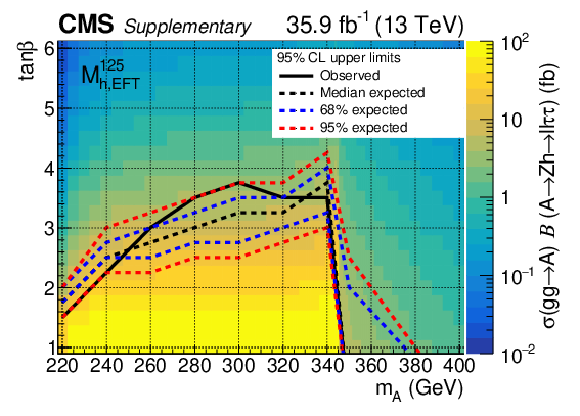
png pdf |
Additional Figure 6:
The expected and observed 95% CL exclusion limits in the $m_{\text {A}}$-$\tan\beta $ plane are shown for the $\mathrm {M^{125}_{{\mathrm {h}},EFT}}$ scenario when only the gluon fusion production process is included. The area under the solid black curve is excluded. The dashed black curve corresponds to the median expected limit, surrounded by the 68 (95)% confidence intervals in blue (red). The limits are overlaid on a background showing the $\sigma ({\mathrm {g}} {\mathrm {g}} \to \text {A})\mathcal {B}(\text {A}\to {\mathrm {Z}} {\mathrm {h}} \to \ell \ell \tau \tau)$ as predicted by the model at each grid point. |
| References | ||||
| 1 | S. L. Glashow | Partial-symmetries of weak interactions | Nuclear Physics 22 (1961) 579 | |
| 2 | S. Weinberg | A model of leptons | PRL 19 (1967) 1264 | |
| 3 | A. Salam | Weak and electromagnetic interactions | in Elementary particle physics: relativistic groups and analyticity, 1968, Proceedings of the eighth Nobel symposium | |
| 4 | F. Englert and R. Brout | Broken symmetry and the mass of gauge vector mesons | PRL 13 (1964) 321 | |
| 5 | P. W. Higgs | Broken symmetries, massless particles and gauge fields | PL12 (1964) 132 | |
| 6 | P. W. Higgs | Broken symmetries and the masses of gauge bosons | PRL 13 (1964) 508 | |
| 7 | G. S. Guralnik, C. R. Hagen, and T. W. B. Kibble | Global conservation laws and massless particles | PRL 13 (1964) 585 | |
| 8 | P. W. Higgs | Spontaneous symmetry breakdown without massless bosons | PR145 (1966) 1156 | |
| 9 | T. W. B. Kibble | Symmetry breaking in non-Abelian gauge theories | PR155 (1967) 1554 | |
| 10 | ATLAS Collaboration | Observation of a new particle in the search for the standard model Higgs boson with the ATLAS detector at the LHC | PLB 716 (2012) 1 | 1207.7214 |
| 11 | CMS Collaboration | Observation of a new boson at a mass of 125 GeV with the CMS experiment at the LHC | PLB 716 (2012) 30 | CMS-HIG-12-028 1207.7235 |
| 12 | CMS Collaboration | Observation of a new boson with mass near 125 GeV in pp collisions at $ \sqrt{s} = $ 7 and 8 TeV | JHEP 06 (2013) 081 | CMS-HIG-12-036 1303.4571 |
| 13 | CMS Collaboration | Measurements of properties of the Higgs boson decaying into the four-lepton final state in pp collisions at $ \sqrt{s}= $ 13 TeV | JHEP 11 (2017) 047 | CMS-HIG-16-041 1706.09936 |
| 14 | ATLAS and CMS Collaborations | Combined measurement of the Higgs boson mass in pp collisions at $ \sqrt{s}= $ 7 and 8 TeV with the ATLAS and CMS experiments | PRL 114 (2015) 191803 | 1503.07589 |
| 15 | ATLAS Collaboration | Measurement of the Higgs boson mass in the $ H\rightarrow ZZ^* \rightarrow 4\ell $ and $ H \rightarrow \gamma\gamma $ channels with $ \sqrt{s}=$ 13 TeV pp collisions using the ATLAS detector | PLB 784 (2018) 345 | 1806.00242 |
| 16 | ATLAS Collaboration | Combined measurements of Higgs boson production and decay using up to 80 fb$ ^{-1} $ of proton-proton collision data at $ \sqrt{s}= $ 13 TeV collected with the ATLAS experiment | Submitted to PRD | 1909.02845 |
| 17 | CMS Collaboration | Combined measurements of Higgs boson couplings in proton-proton collisions at $ \sqrt{s} = $ 13 TeV | EPJC 79 (2019) 421 | CMS-HIG-17-031 1809.10733 |
| 18 | T. D. Lee | A theory of spontaneous T violation | PRD 8 (1973) 1226 | |
| 19 | G. C. Branco et al. | Theory and phenomenology of two-Higgs-doublet models | PR 516 (2012) 1 | 1106.0034 |
| 20 | H. Bahl, S. Liebler, and T. Stefaniak | MSSM Higgs benchmark scenarios for Run 2 and beyond: the low $ \tan \beta $ region | EPJC 79 (2019) 279 | 1901.05933 |
| 21 | A. Djouadi and J. Quevillon | The MSSM Higgs sector at a high $ M_{SUSY} $: reopening the low tan$ \beta $ regime and heavy Higgs searches | JHEP 10 (2013) 028 | 1304.1787 |
| 22 | L. Maiani, A. D. Polosa, and V. Riquer | Bounds to the Higgs sector masses in minimal supersymmetry from LHC data | PLB 724 (2013) 274 | 1305.2172 |
| 23 | A. Djouadi et al. | The post-Higgs MSSM scenario: Habemus MSSM? | EPJC 73 (2013) 2650 | 1307.5205 |
| 24 | A. Djouadi et al. | Fully covering the MSSM Higgs sector at the LHC | JHEP 06 (2015) 168 | 1502.05653 |
| 25 | ATLAS Collaboration | Search for a CP-odd Higgs boson decaying to Zh in pp collisions at $ \sqrt{s} = $ 8 TeV with the ATLAS detector | PLB 744 (2015) 163 | 1502.04478 |
| 26 | CMS Collaboration | Searches for a heavy scalar boson H decaying to a pair of 125 GeV Higgs bosons hh or for a heavy pseudoscalar boson A decaying to Zh, in the final states with $ h \to \tau \tau $ | PLB 755 (2016) 217 | CMS-HIG-14-034 1510.01181 |
| 27 | ATLAS Collaboration | Search for heavy resonances decaying into a $ W $ or $ Z $ boson and a Higgs boson in final states with leptons and $ b $-jets in 36 fb$ ^{-1} $ of $ \sqrt s = $ 13 TeV pp collisions with the ATLAS detector | JHEP 03 (2018) 174 | 1712.06518 |
| 28 | CMS Collaboration | Search for a heavy pseudoscalar boson decaying to a Z and a Higgs boson at $ \sqrt{s} = $ 13 TeV | EPJC 79 (2019) 564 | CMS-HIG-18-005 1903.00941 |
| 29 | L. Bianchini et al. | Reconstruction of the Higgs mass in events with Higgs bosons decaying into a pair of $ \tau $ leptons using matrix element techniques | NIMA 862 (2017) 54 | 1603.05910 |
| 30 | CMS Collaboration | The CMS trigger system | JINST 12 (2017) P01020 | CMS-TRG-12-001 1609.02366 |
| 31 | CMS Collaboration | The CMS experiment at the CERN LHC | JINST 3 (2008) S08004 | CMS-00-001 |
| 32 | J. Alwall et al. | The automated computation of tree-level and next-to-leading order differential cross sections, and their matching to parton shower simulations | JHEP 07 (2014) 079 | 1405.0301 |
| 33 | M. Carena et al. | MSSM Higgs boson searches at the LHC: Benchmark scenarios after the discovery of a Higgs-like particle | EPJC 73 (2013) 2552 | 1302.7033 |
| 34 | P. Nason | A new method for combining NLO QCD with shower Monte Carlo algorithms | JHEP 11 (2004) 040 | hep-ph/0409146 |
| 35 | S. Frixione, P. Nason, and C. Oleari | Matching NLO QCD computations with parton shower simulations: the POWHEG method | JHEP 11 (2007) 070 | 0709.2092 |
| 36 | S. Alioli, P. Nason, C. Oleari, and E. Re | A general framework for implementing NLO calculations in shower Monte Carlo programs: the POWHEG BOX | JHEP 06 (2010) 043 | 1002.2581 |
| 37 | S. Alioli et al. | Jet pair production in POWHEG | JHEP 04 (2011) 081 | 1012.3380 |
| 38 | S. Alioli, P. Nason, C. Oleari, and E. Re | NLO Higgs boson production via gluon fusion matched with shower in POWHEG | JHEP 04 (2009) 002 | 0812.0578 |
| 39 | G. Luisoni, P. Nason, C. Oleari, and F. Tramontano | $ HW^{\pm}$/$HZ$ + 0 and 1 jet at NLO with the POWHEG BOX interfaced to GoSam and their merging within MiNLO | JHEP 10 (2013) 083 | 1306.2542 |
| 40 | D. de Florian, G. Ferrera, M. Grazzini, and D. Tommasini | Higgs boson production at the LHC: Transverse momentum resummation effects in the $ \mathrm{H}\rightarrow \gamma\gamma $, $ \mathrm{H}\rightarrow {WW} \rightarrow l\nu l\nu $ and $ \mathrm{H}\rightarrow {ZZ}\rightarrow 4l $ decay modes | JHEP 06 (2012) 132 | 1203.6321 |
| 41 | M. Grazzini and H. Sargsyan | Heavy-quark mass effects in Higgs boson production at the LHC | JHEP 09 (2013) 129 | 1306.4581 |
| 42 | LHC Higgs Cross Section Working Group | Handbook of LHC Higgs cross sections: 4. Deciphering the nature of the Higgs sector | 1610.07922 | |
| 43 | A. Denner et al. | Standard model Higgs-boson branching ratios with uncertainties | EPJC 71 (2011) 1753 | 1107.5909 |
| 44 | NNPDF Collaboration | Impact of heavy quark masses on parton distributions and LHC phenomenology | NPB 849 (2011) 296 | 1101.1300 |
| 45 | J. M. Campbell and R. K. Ellis | MCFM for the Tevatron and the LHC | NPB Proc. Suppl. 205-206 (2010) 10 | 1007.3492 |
| 46 | R. Frederix and S. Frixione | Merging meets matching in MC@NLO | JHEP 12 (2012) 061 | 1209.6215 |
| 47 | J. Alwall et al. | Comparative study of various algorithms for the merging of parton showers and matrix elements in hadronic collisions | EPJC 53 (2008) 473 | 0706.2569 |
| 48 | T. Sjostrand et al. | An introduction to PYTHIA 8.2 | CPC 191 (2015) 159 | 1410.3012 |
| 49 | CMS Collaboration | Event generator tunes obtained from underlying event and multiparton scattering measurements | EPJC 76 (2016) 155 | CMS-GEN-14-001 1512.00815 |
| 50 | R. D. Ball et al. | Unbiased global determination of parton distributions and their uncertainties at NNLO and at LO | NPB 855 (2012) 153 | 1107.2652 |
| 51 | GEANT4 Collaboration | GEANT4--a simulation toolkit | NIMA 506 (2003) 250 | |
| 52 | S. Heinemeyer, W. Hollik, and G. Weiglein | FeynHiggs: A program for the calculation of the masses of the neutral CP-even Higgs bosons in the MSSM | CPC 124 (2000) 76 | hep-ph/9812320 |
| 53 | S. Heinemeyer, W. Hollik, and G. Weiglein | The masses of the neutral CP-even Higgs bosons in the MSSM: Accurate analysis at the two-loop level | EPJC 9 (1999) 343 | hep-ph/9812472 |
| 54 | G. Degrassi et al. | Towards high-precision predictions for the MSSM Higgs sector | EPJC 28 (2003) 133 | hep-ph/0212020 |
| 55 | M. Frank et al. | The Higgs boson masses and mixings of the complex MSSM in the Feynman-diagrammatic approach | JHEP 02 (2007) 047 | hep-ph/0611326 |
| 56 | T. Hahn et al. | High-precision predictions for the light CP-even Higgs boson mass of the minimal supersymmetric standard model | PRL 112 (2014) 141801 | 1312.4937 |
| 57 | R. V. Harlander, S. Liebler, and H. Mantler | SusHi: A program for the calculation of Higgs production in gluon fusion and bottom-quark annihilation in the standard model and the MSSM | CPC 184 (2013) 1605 | 1212.3249 |
| 58 | R. V. Harlander, S. Liebler, and H. Mantler | SusHi Bento: Beyond NNLO and the heavy-top limit | CPC 212 (2017) 239 | 1605.03190 |
| 59 | M. Spira, A. Djouadi, D. Graudenz, and P. M. Zerwas | Higgs boson production at the LHC | NPB 453 (1995) 17 | hep-ph/9504378 |
| 60 | R. V. Harlander and M. Steinhauser | Supersymmetric Higgs production in gluon fusion at next-to-leading order | JHEP 09 (2004) 066 | hep-ph/0409010 |
| 61 | R. Harlander and P. Kant | Higgs production and decay: Analytic results at next-to-leading order QCD | JHEP 12 (2005) 015 | hep-ph/0509189 |
| 62 | G. Degrassi and P. Slavich | NLO QCD bottom corrections to Higgs boson production in the MSSM | JHEP 11 (2010) 044 | 1007.3465 |
| 63 | G. Degrassi, S. Di Vita, and P. Slavich | NLO QCD corrections to pseudoscalar Higgs production in the MSSM | JHEP 08 (2011) 128 | 1107.0914 |
| 64 | G. Degrassi, S. Di Vita, and P. Slavich | On the NLO QCD corrections to the production of the heaviest neutral Higgs scalar in the MSSM | EPJC 72 (2012) 2032 | 1204.1016 |
| 65 | R. V. Harlander and W. B. Kilgore | Next-to-next-to-leading order Higgs production at hadron colliders | PRL 88 (2002) 201801 | hep-ph/0201206 |
| 66 | C. Anastasiou and K. Melnikov | Higgs boson production at hadron colliders in NNLO QCD | NPB 646 (2002) 220 | hep-ph/0207004 |
| 67 | V. Ravindran, J. Smith, and W. L. van Neerven | NNLO corrections to the total cross-section for Higgs boson production in hadron-hadron collisions | NPB 665 (2003) 325 | hep-ph/0302135 |
| 68 | R. V. Harlander and W. B. Kilgore | Production of a pseudo-scalar Higgs boson at hadron colliders at next-to-next-to leading order | JHEP 10 (2002) 017 | hep-ph/0208096 |
| 69 | C. Anastasiou and K. Melnikov | Pseudoscalar Higgs boson production at hadron colliders in next-to-next-to-leading order QCD | PRD 67 (2003) 037501 | hep-ph/0208115 |
| 70 | U. Aglietti, R. Bonciani, G. Degrassi, and A. Vicini | Two-loop light fermion contribution to Higgs production and decays | PLB 595 (2004) 432 | hep-ph/0404071 |
| 71 | R. Bonciani, G. Degrassi, and A. Vicini | On the generalized harmonic polylogarithms of one complex variable | CPC 182 (2011) 1253 | 1007.1891 |
| 72 | R. V. Harlander and W. B. Kilgore | Higgs boson production in bottom quark fusion at next-to-next-to leading order | PRD 68 (2003) 013001 | hep-ph/0304035 |
| 73 | S. Dittmaier, M. Kramer, and M. Spira | Higgs radiation off bottom quarks at the Fermilab Tevatron and the CERN LHC | PRD 70 (2004) 074010 | hep-ph/0309204 |
| 74 | S. Dawson, C. B. Jackson, L. Reina, and D. Wackeroth | Exclusive Higgs boson production with bottom quarks at hadron colliders | PRD 69 (2004) 074027 | hep-ph/0311067 |
| 75 | R. Harlander, M. Kramer, and M. Schumacher | Bottom-quark associated Higgs-boson production: reconciling the four- and five-flavour scheme approach | 1112.3478 | |
| 76 | M. Bonvini, A. S. Papanastasiou, and F. J. Tackmann | Resummation and matching of b-quark mass effects in $ b\overline{b}H $ production | JHEP 11 (2015) 196 | 1508.03288 |
| 77 | M. Bonvini, A. S. Papanastasiou, and F. J. Tackmann | Matched predictions for the $ b\overline{b}H $ cross section at the 13 TeV LHC | JHEP 10 (2016) 053 | 1605.01733 |
| 78 | S. Forte, D. Napoletano, and M. Ubiali | Higgs production in bottom-quark fusion in a matched scheme | PLB 751 (2015) 331 | 1508.01529 |
| 79 | S. Forte, D. Napoletano, and M. Ubiali | Higgs production in bottom-quark fusion: matching beyond leading order | PLB 763 (2016) 190 | 1607.00389 |
| 80 | A. Djouadi, J. Kalinowski, and M. Spira | HDECAY: A program for Higgs boson decays in the standard model and its supersymmetric extension | CPC 108 (1998) 56 | hep-ph/9704448 |
| 81 | A. Djouadi, M. M. Muhlleitner, and M. Spira | Decays of supersymmetric particles: The program SUSY-HIT (SUspect-SdecaY-Hdecay-InTerface) | in Physics at LHC. Proceedings, 3rd Conference, p. 635 Cracow, Poland, July, 2006 [Acta Phys. Polon. B 38 (2007) 38] | hep-ph/0609292 |
| 82 | A. Djouadi, J. Kalinowski, M. Muhlleitner, and M. Spira | HDECAY: Twenty$ _{++} $ years after | CPC 238 (2019) 214 | 1801.09506 |
| 83 | CMS Collaboration | Particle-flow reconstruction and global event description with the CMS detector | JINST 12 (2017) P10003 | CMS-PRF-14-001 1706.04965 |
| 84 | M. Cacciari, G. P. Salam, and G. Soyez | FastJet user manual | EPJC 72 (2012) 1896 | 1111.6097 |
| 85 | M. Cacciari and G. P. Salam | Dispelling the $ N^{3} $ myth for the $ {k_{\mathrm{T}}} $ jet-finder | PLB 641 (2006) 57 | hep-ph/0512210 |
| 86 | M. Cacciari, G. P. Salam, and G. Soyez | The anti-$ {k_{\mathrm{T}}} $ jet clustering algorithm | JHEP 04 (2008) 063 | 0802.1189 |
| 87 | CMS Collaboration | Jet energy scale and resolution in the CMS experiment in pp collisions at 8 TeV | JINST 12 (2017) P02014 | CMS-JME-13-004 1607.03663 |
| 88 | CMS Collaboration | Performance of missing transverse momentum reconstruction in proton-proton collisions at $ \sqrt{s} = $ 13 TeV using the CMS detector | JINST 14 (2019) P07004 | CMS-JME-17-001 1903.06078 |
| 89 | CMS Collaboration | Performance of electron reconstruction and selection with the CMS detector in proton-proton collisions at $ \sqrt{s}= $ 8 TeV | JINST 10 (2015) P06005 | CMS-EGM-13-001 1502.02701 |
| 90 | CMS Collaboration | Performance of the CMS muon detector and muon reconstruction with proton-proton collisions at $ \sqrt{s}= $ 13 TeV | JINST 13 (2018) P06015 | CMS-MUO-16-001 1804.04528 |
| 91 | CMS Collaboration | Identification of heavy-flavour jets with the CMS detector in pp collisions at 13 TeV | JINST 13 (2017) P05011 | CMS-BTV-16-002 1712.07158 |
| 92 | CMS Collaboration | Reconstruction and identification of $ \tau $ lepton decays to hadrons and $ \nu_\tau $ at CMS | JINST 11 (2016) P01019 | CMS-TAU-14-001 1510.07488 |
| 93 | CMS Collaboration | Performance of reconstruction and identification of $ \tau $ leptons decaying to hadrons and $ \nu_\tau $ in pp collisions at $ \sqrt{s}= $ 13 TeV | JINST 13 (2018) P10005 | CMS-TAU-16-003 1809.02816 |
| 94 | J. Butterworth et al. | PDF4LHC recommendations for LHC Run II | JPG 43 (2016) 023001 | 1510.03865 |
| 95 | CMS Collaboration | Measurements of the Higgs boson width and anomalous $ HVV $ couplings from on-shell and off-shell production in the four-lepton final state | PRD 99 (2019) 112003 | CMS-HIG-18-002 1901.00174 |
| 96 | CMS Collaboration | Measurement of the cross section for top quark pair production in association with a W or Z boson in proton-proton collisions at $ \sqrt{s} = $ 13 TeV | JHEP 08 (2018) 011 | CMS-TOP-17-005 1711.02547 |
| 97 | R. J. Barlow and C. Beeston | Fitting using finite Monte Carlo samples | CPC 77 (1993) 219 | |
| 98 | CMS Collaboration | CMS luminosity measurements for the 2016 data taking period | CMS-PAS-LUM-17-001 | CMS-PAS-LUM-17-001 |
| 99 | T. Junk | Confidence level computation for combining searches with small statistics | NIMA 434 (1999) 435 | hep-ex/9902006 |
| 100 | A. L. Read | Presentation of search results: The CL$ _{\text{s}} $ technique | JPG 28 (2002) 2693 | |
| 101 | ATLAS and CMS Collaborations, The LHC Higgs Combination Group | Procedure for the LHC Higgs boson search combination in Summer 2011 | CMS-NOTE-2011-005 | |
| 102 | G. Cowan, K. Cranmer, E. Gross, and O. Vitells | Asymptotic formulae for likelihood-based tests of new physics | EPJC 71 (2011) 1554 | 1007.1727 |
| 103 | ATLAS Collaboration | Search for heavy resonances decaying into $ WW $ in the $ e\nu\mu\nu $ final state in $ pp $ collisions at $ \sqrt{s}= $ 13 TeV with the ATLAS detector | EPJC 78 (2018) 24 | 1710.01123 |
| 104 | ATLAS Collaboration | Search for heavy $ ZZ $ resonances in the $ \ell^+\ell^-\ell^+\ell^- $ and $ \ell^+\ell^-\nu\bar\nu $ final states using proton proton collisions at $ \sqrt{s}= $ 13 TeV with the ATLAS detector. Search for heavy $ ZZ $ resonances in the $ \ell^+\ell^-\ell^+\ell^- $ and $ \ell^+\ell^-\nu\bar\nu $ final states using proton proton collisions at $ \sqrt{s}= $ 13 TeV with the ATLAS detector | EPJC 78 (2018) 293 | 1712.06386 |

|
Compact Muon Solenoid LHC, CERN |

|

|

|

|

|

|